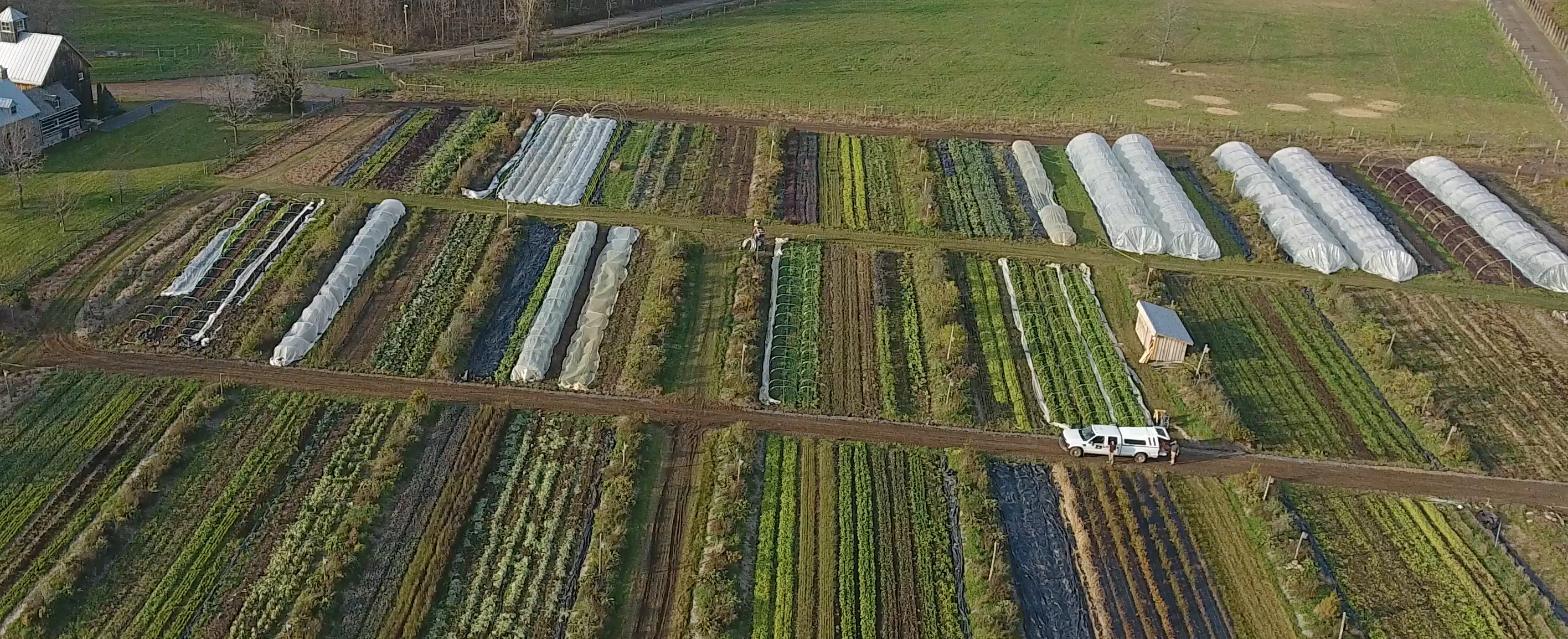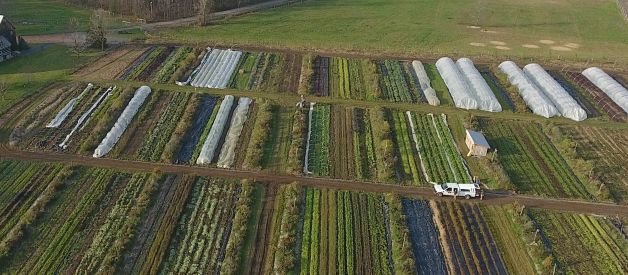Many people who are new to small-scale organic farming come in with a lot of expectations and assumptions on how things are going to be. The romantic idea of living off the land and farming within a sustainable community has lured them closer to taking action and getting something going, whether it be a small farm, an off-grid homestead or perhaps just an ambitious garden. A lot of these folks have been inspired by the Permaculture movement, read the books of Bill Mollison, watched YouTube videos with Geoff Lawton and dreamed up enough ideas about herb spirals and forest gardens to make your head spin. I was exactly one of those people when I started my farm, I was inspired by Mollison and Lawton immensely and the idea of a self-sustaining farm was my dream and I was going to make it a reality, no matter the cost. It didn?t all pan out that way, because even in my first year of farming, I got smacked in the face with a hard dose of reality and many of the promises of Permaculture simply didn?t work at all or were so impractical that they were nearly impossible to implement on a commercial scale, even on a small farm like mine (.25 acres). I have identified five slogans that are tirelessly repeated in the permaculture space that I would like to dispel. They are so often repeated without question that I feel they have become cult-like and dogmatic. Many people take these slogans at face value and I see a lot of farmers and homesteaders burning out as a result because they were promised something that didn?t deliver. It?s great to showcase successful models and inspire people to start farming themselves, but I think it?s just as important to properly set up expectations and always explain things from a contextual framework, which is something many permaculture instructors don?t do. Having said that, there are many that do as well, so I?m in no way going after individual permaculture teachers, I?m going after five of the ideas that I see as falsehoods.
I?d like to start with some definitions of terms that are going to be helpful to understand if this article is going to be effective.
Permaculture has become quite a nebulous term in that many people define it in different ways. I refer to the definition as used by Mollison as a combination of two words; Permanent and Agriculture, permanent agriculture = Permaculture. Mollison?s main criticism of conventional annual based agriculture was that it was not sustainable because nothing about it was permanent. Because of mass soil cultivation and petrochemicals used in conventional agriculture, topsoil is continuously mined away and biodiversity loss. A constant state of diminishing returns. His idea was to create a system of permanent agriculture. It is also commonly referred to a design system based on observing patterns in nature.
Context
I use the term context to illustrate that your experience with something might not be the same as someone else?s. For example, you live on a farm in a high and dry arid climate, therefore creating swales to hold moisture might make sense for your context, but it doesn?t for someone living in a wet and low elevation climate. Context is critical to understand before applying any solution to a problem. It?s the lens through which we view the world and solutions are tools in a toolkit.
I would also like to recognize what Permaculture got right. First, using the idea as a design method based in observation of natural systems is a great way in which to approach working with anything. I?m not sure this idea is exclusive to Permaculture, but it was certainly iterated a lot by the key figures in the movement. Second, critique of monoculture. It?s clear that monoculture invites a whole host of ecological problems. On a basic principles level, monocultures don?t exist anywhere in nature. Looking at that through the Permaculture lens of observation is very important and I think it can be very helpful.
The five myths I will dispel are as follows: The Self-Sustaining Farm, The Lazy Gardener, Mulch Everything, Swale Everything, No Pests! I?d like to analyze each of these, where they came from, why they are perpetuated and why they are false. I want to make something very clear. I am not here to criticize these ideas for the ideas alone, frankly, I still think all of this stuff is very interesting and lovely. My critiques are all coming from the fact that Mollison, Lawton and many others have criticized conventional agriculture and have offered these as solutions. If they had said, these were only solutions for a home scale garden, we probably wouldn?t be having this discussion. I?m also not saying that Mollison and Lawton are responsible for these falsehoods being perpetuated either. I think they have become cultural memes that have been compounded as the movement has stepped into the mainstream.
1. The Self-Sustaining Farm
Bill Mollison, Geoff Lawton, Robert Hart and Patrick Whitefield developed the idea of The Forest Garden in the early 90?s and there are many books written on the subject and there are many other authors to mention as well. A forest garden is a fantastic idea in principle. The basic premise is that you can establish a food production system based on the natural ecology of a forest. You take the time to establish the system and once it?s set up, it will produce food consistently and you?ll get to walk around like Adam and Eve and just pick and eat without doing much work. The problem with this is that agriculture doesn?t work that way. There are many reasons for that, but the primary reason is that agriculture does not exist in nature. It?s a manmade system. As much as we?d like it to reflect aspects of nature, it can only to a small degree, because in order for a food system to be dependable, it needs to produce predictable yields on a consistent basis otherwise it can?t scale. In order to deliver those results, trees need to be pruned, annuals reseeded and crops harvested. In a forest garden, where most of the crops are perennial and scattered around much like they would be in a forest, it?s very difficult to streamline production systems in regards to harvesting and planting. So much time would be spent aimlessly walking around to find things. Now, if we?re talking about establishing a forest garden for your property and it?s more about the lifestyle, that is something entirely different and that?s perfectly fine as far as I?m concerned. Most people I talk to understand this when we clearly define the context of the forest garden, but there is so much idealism about it, that many people think that this idea can be applied to a larger scale agricultural system. I do believe that it is a possibility but I have yet to see this really play out as a profitable and scalable model. There are people out there like Mark Shepard trying to make the model work, but from what I can see, there?s not lot of production coming off those farms. In fact, the parts I see as being the most productive are the annual vegetable row crops they have interplanted amongst the trees, which makes sense. The reason this myth can hurt people is that it puts the idea in their head that a farm is going to take care of itself and that is the furthest thing from the truth. Farming is hard and consistent work. Telling anyone otherwise is over-promising because the reality is going to kick them in the ass when the work to harvest, plant and maintain has to get done. The other part is this idea that growing perennial crops is easier than growing annuals. This has been reiterated by the likes of Mark Shepard and Toby Hemenway (RIP), two people who I have great respect for, but I would say to that, compared to what and when? Sure, annual vegetables are more work in that they produce far more food and more consistently, so that is somewhat self-evident. At the same time, see what happens if you don?t prune an orchard or a vineyard for a year. It?s an immense amount of work to get it back to where it was and you?ll most likely suffer a lot of production for a season. Annual based agriculture has also been more work at different times in history. Agriculture is now more productive on less land and with less people working than ever in recorded history. So, it?s one thing to criticize the status quo, but it?s also very important to understand the context within the greater picture of time and the details. Nothing that is worthwhile comes easy. I have found this to be universally true, especially in agriculture. This is not to say that farming should not be made easier and it?s why farmers should be continuously focused on working smart than working hard.
The forest garden of Robert Hart
2. The Lazy Gardener
The Lazy Gardener idea was perpetuated by Mollison in his early work and it sort of ties into the forest garden, in that you can plant some things and forget about them. The one video I love and still find kind of funny, because Mollison was a charismatic and entertaining person, is the video of him planting some potatoes with newspaper mulch. I?m not saying that you can?t grow things by using these ideas, I?m saying that you shouldn?t expect them to scale. The idea of the Lazy Gardener has become a cultural meme and all you have to do is look at all the videos on YouTube with that in the title. I?m not saying don?t be a lazy gardener, but if you?re going to be lazy, adjust your expectations. Again, nothing worthwhile comes easy. It all requires work. Whenever I visit a farm or homestead of someone who has been inspired by the lazy gardening method, I see a lot of weeds and not a lot of production. Again, context is key. If your context is to be a lazy gardener and you don?t want to put in a lot of work, fine, but don?t expect to make a significant contribution to the food system or let alone, make a good living from it.
3. Mulch Everything
There are many different forms of mulch, but the most commonly known in permaculture is straw mulch. Maybe it?s a context thing, but in my experience, straw mulch is the most impractical mulch to use on a garden or a farm. First of all, it?s not that cheap, second, it often has seeds in it and will grow back, and third, it requires a lot of manual labour to spread. You can?t spread it with a machine. Mulch in principle is a great idea. It suppresses weeds, contains soil moisture, prevents soil erosion and can keep soil cool in hot weather. In practice, spreading mulch is a ton of work and it?s not that practical for many crop types. There are some places where it can make a lot of sense, particularly long-term annuals like squashes and nightshades. It can also be great on perennial crops. However, for most annuals, especially ones where you?ll have multiple successions in a season, it makes little to no sense at all. If you are going to do multiple rotations in a bed, where one crop is planted, then later harvested, then the bed is re-amended with compost, manure or fertilizer, then planted again, mulch is just a nuisance because you have to remove it before you prepare to plant again. Most direct seed and transplanting implements will not penetrate the mulch. That means it must be done by hand. However, there might be technology coming that will do this effectively, but I haven?t seen it yet and when it comes out, I?ll be happy to update my statement. Another problem that is often overlooked with mulch is that it keeps the soil cool. That might be great in the summer, but it sucks at the beginning of the season when you want to warm the soil to expedite your crops. Too much mulch can also create a habitat for pests like mice and voles because it just gives them more places to hide and nest. I?ve seen so many farmers figure this out the hard way, where they had spent years mulching their farms just to peel it all off years later. There are far more practical ways to incorporate mulch onto a farm. The first and foremost should be to look at the crop as the mulch itself. By using bio-intensive style planting densities, once a crop is 50?75% mature, it grows a canopy of foliage that will cover the soil and function as a weed suppressant, soil canopy to prevent erosion and baking in the sun. There are also synthetic mulches that are far more practical to use such as biodegradable plastic mulch. My favourite is landscape fabric, which can be reused for many years. The biggest problem I see with the Mulch Everything myth is that many farmers spend a lot of time and money mulching everything, just to get rid of it later. That?s a lot of wasted resources for a lot of people.
Here are two examples on how small commercial farmers like myself are using mulch.
Flail Mower to mulch beds
Landscape Fabric beds
4. Swale Everything
A swale is a mound of earth that is made on contour with the natural grade of the land. The idea is to create a depression on the hillside that will hold moisture and create what is known as a plume deep underneath the soil where water will build up. It?s also another great idea in principle, but in practice requires a lot of work. It?s another one of these ideas that seem so cool. I remember the first time I watched Geoff Lawton film Harvesting Water The Permaculture Way, I was blown away. I live in a high desert climate and I remember looking around at all the farms in the region, then asking myself why do all the orchards and vineyards here not do this? They must all be stupid! It turns out, there are many reasons why you wouldn?t put swales on a farm. First of all, they?re a ton of work. To build them with hand tools would be crazy, most use a backhoe, and even then, they?re time-consuming and costly. Second, they interfere with the grid of your land, so that if you need to have things in rows or straight lines for production purposes, it makes that very difficult and inefficient. Thirdly, not all crops and farms need that amount of water retention. I?ve heard horror stories of permaculture consultants putting swales on land that shouldn?t have had them, now there are problems with too much water retention that has led to landslides. Swales can cause a serious problem down the road if not done right. A method of installing water retention into the landscape that is far more practical is to use a Key-line plow, which rips a deep cut into the land, but without the backhoe and the mess that creates. It can also allow a farm to keep their traditional rows. Even still, context is everything here. Many farms don?t need more water retention. It all depends on the climate you?re in and the specific needs of your farm.
Geoff Lawton discussing swales
5. No Pests with Beneficial Insects and Plants
This is one slogan that I hear every workshop that I teach and I?m not exactly sure where it came from. I might be like a game of Telephone where it?s been said here and there by so many people for so long, that the origin is totally lost. The idea here is that by planting certain flowers and creating habitat for bugs, bees, and birds, you will have no pest problems on a farm. It?s also one where I?ve seen people waste a lot of time pursuing with little to no results. This is not to say it can?t work, maybe there?s some way to do it, but like all of these, it?s really hard to scale. On any commercial farm, there are going to be pests. If you think you can avoid pests on your farm by planting some beneficial flowers around, think again, you maybe in for a rude awakening. In my experience, the best way to approach pests organically is to proactively manage them before they become a problem. Covering crops with insect netting and or timed cropping strategies that avoid the gestation cycles of certain pests for the corresponding crop is a far more practical solution that will deliver measurable results. Proper crop rotations and crop diversity are also very important. In an enclosed environment like a greenhouse nursery, beneficial insects can certainly be effective, but these are almost always imported and prescribed just like pharmaceutical drugs. Perhaps the most impressive farm I?ve seen that has used a somewhat permaculture approach to beneficial bugs, birds and plants is at La Ferme des Quatre-Temps in Hemmingford, Quebec. But even then, I can?t say for sure if it?s working because they still use insect netting as their predominate pest protection strategy.
Hedgerows as a form of integrated pest management at La Ferme des Quatre-Temps

Context is everything when looking at sustainable solutions for agriculture. You?ve got to understand where, when, and how something is going to fit within your own framework or in this case, the broader one. It?s quite possible that one solution you see someone else using is not going to fit within your context. We can?t expect that every solution to work in every place and I think that?s the root of the problem here. It?s one thing to criticize conventional and industrial agriculture, but if you?re going to offer solutions, they should fit within the context of those systems. It?s sort of ironic that many people within the Permaculture scene gravitate towards a singular cause or effect when critiquing agriculture or the world at large, because that in itself is a monoculture of thinking. People often view one problem as the root cause to everything and then they view one solution as the solution for everything. This is where I believe that some of the foundational principles within Permaculture need to be revisited. If we?re going to respect and look for diversity in our approach, we should also apply that same logic across the board.


